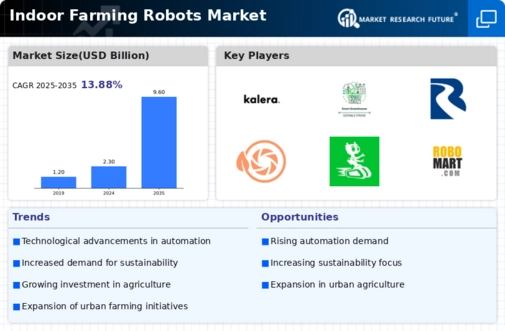Market Share
Indoor Farming Robots Market Share Analysis
In the competitive landscape of the indoor farming robots market, companies employ various market share positioning strategies to gain a foothold and differentiate themselves from competitors. One common strategy is product differentiation, where companies focus on developing unique features or capabilities that set their robots apart. For example, some companies may emphasize the precision and accuracy of their robots' sensors and actuators, while others may highlight their robots' ability to optimize resource usage or adapt to different crop varieties. By offering distinct advantages, companies can attract customers who prioritize specific functionalities or performance metrics, thereby capturing a segment of the market.
Another key strategy is pricing positioning, where companies adjust their pricing strategies to target different market segments. Some companies may opt for a premium pricing strategy, positioning their robots as high-end solutions with superior performance and reliability. These companies often target commercial growers or large-scale farming operations willing to invest in advanced technology to maximize their yields and efficiency. On the other hand, other companies may adopt a value-based pricing strategy, offering more affordable options tailored to the needs of smaller growers or hobbyists. By catering to different price points, companies can expand their customer base and capture market share across various segments.
Furthermore, companies may pursue a market segmentation strategy, where they divide the market into distinct segments based on factors such as geographic location, crop type, or customer demographics. By identifying niche markets with specific needs or preferences, companies can tailor their marketing efforts and product offerings to better address the unique requirements of each segment. For example, a company may focus on serving urban farmers in densely populated areas who value space-efficient and automated solutions for indoor cultivation. By understanding the diverse needs of different segments, companies can effectively target their resources and capture market share in specific niches.
Moreover, partnerships and collaborations can be effective market share positioning strategies for companies looking to expand their reach and capabilities. By forming strategic alliances with other industry players, technology providers, or agricultural organizations, companies can leverage complementary strengths and resources to enhance their competitive advantage. For example, a robotics company may partner with a greenhouse manufacturer to offer integrated solutions that combine robotics with optimized growing environments. By pooling expertise and resources, companies can deliver more comprehensive solutions that address the evolving needs of customers and gain a stronger foothold in the market.
Additionally, branding and marketing play a crucial role in shaping market share positioning strategies. Companies invest in building strong brands and establishing themselves as industry leaders or innovators to differentiate their offerings and gain credibility among customers. Effective branding and marketing campaigns can help companies create awareness, generate demand, and influence purchasing decisions in their favor. By consistently communicating their value proposition and unique selling points, companies can strengthen their market position and attract customers away from competitors.
















Leave a Comment